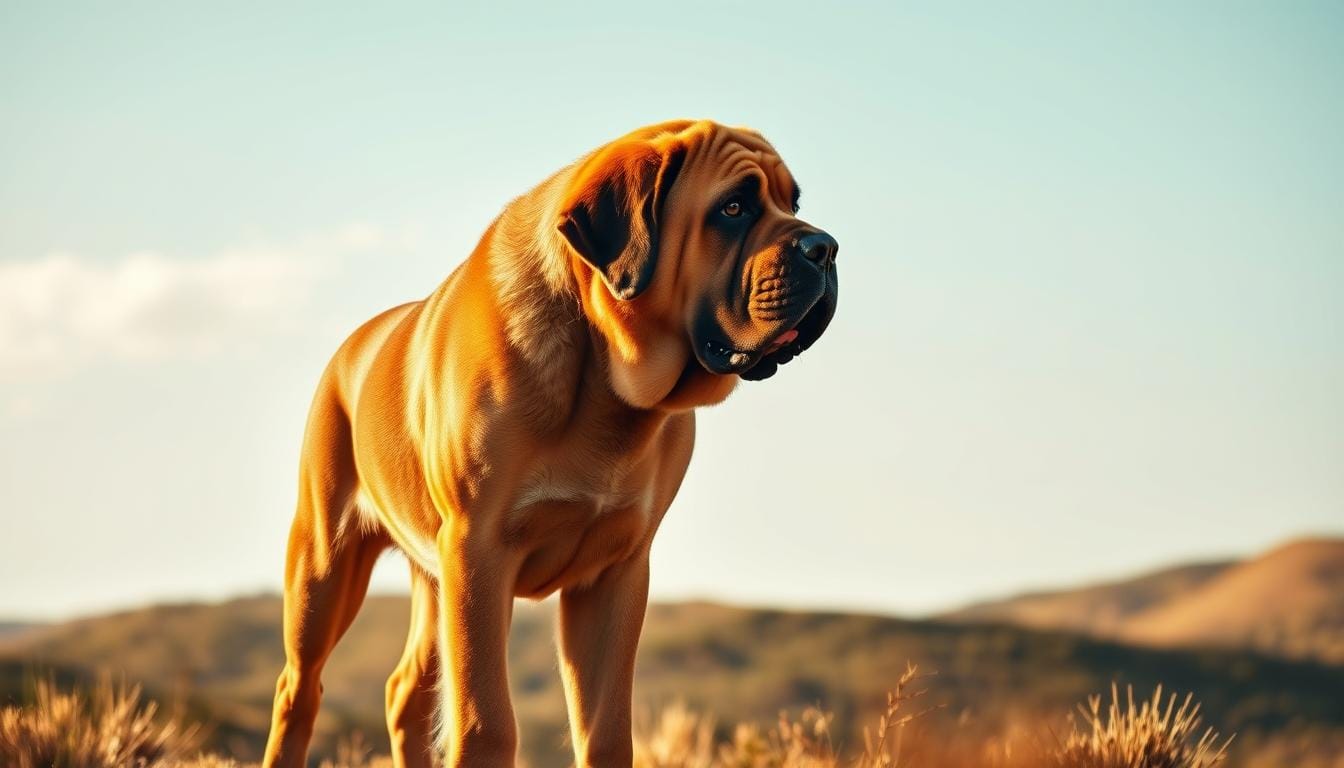Exploring the Magnificent Spanish Mastiff
Thinking about getting a new large dog? The Spanish Mastiff might catch your eye. This loyal and protective dog has a rich history and is a beloved family pet. It’s known for its strength, courage, and devotion, making it a true guardian.
The Spanish Mastiff needs a lot of care, including exercise, food, and grooming. They live for 10-12 years, which is a big commitment. But, they bring joy and protection to families. If you’re looking for a loyal friend, the Spanish Mastiff is worth considering.
Table of Contents
Key Takeaways
- The Spanish Mastiff is a loyal and protective large dog breed
- This livestock guardian dog has a rich history and cultural significance
- With proper care, the Spanish Mastiff can thrive as a beloved family companion
- Exercise, feeding, and grooming needs must be carefully considered
- The Spanish Mastiff has a lifespan of 10-12 years, making it a long-term commitment
- Early socialization and training are critical to reduce wariness of strangers and ensure good manners
The Rich History of the Spanish Mastiff
The Spanish Mastiff’s history is long and fascinating, starting in the Iberian Peninsula. It was bred to guard livestock from predators. Its role in protecting animals is well-documented.
The Spanish Mastiff’s history spans centuries. It began as a working dog and is now a cherished pet. It’s known for its loyalty, smarts, and protective nature.
Ancient Origins in the Iberian Peninsula
The Spanish Mastiff comes from the Iberian Peninsula. It was first used to guard livestock. It was a working dog, protecting animals and property from threats.
Traditional Role as a Livestock Guardian
The Spanish Mastiff was bred to protect its flock. Its size, strength, and look scared off predators. Its loyalty and smarts made it a great help to farmers and herders.
Today, the Spanish Mastiff guards livestock and is a family pet. It’s gentle and loving. Its loyalty and protective nature make it a great family member.
| Characteristics | Description |
|---|---|
| Size | Large |
| Build | Powerful |
| Temperament | Gentle and affectionate |
Physical Characteristics of the Spanish Mastiff
The Spanish Mastiff is a large dog breed, known for its impressive size and weight. On average, a Spanish Mastiff can weigh between 140 to 200 pounds and stand between 28 to 35 inches tall. This large size is a key characteristic of the breed, and it plays a significant role in its ability to serve as a guardian and companion.
Some of the key physical characteristics of the Spanish Mastiff include its muscular build and deep chest. The breed’s height range for males is generally between 28 to 35 inches, while females stand between 26 to 34 inches. The weight range for Spanish Mastiffs is typically between 54 to 90 kg, with some individuals reaching up to 200 pounds.
Here are some key statistics about the Spanish Mastiff’s physical characteristics:
- Height range: 72-85 cm
- Weight range: 54-90 kg
- Body weight: up to three times that of an average medium-sized dog
- Bite force: estimated between 550 to 700 psi
The Spanish Mastiff’s large size and weight make it a formidable breed, but they also require careful consideration when it comes to training and socialization. With proper care and attention, the Spanish Mastiff can thrive as a loyal and loving companion.
| Characteristic | Value |
|---|---|
| Height range (male) | 28-35 inches |
| Height range (female) | 26-34 inches |
| Weight range | 54-90 kg |
Understanding Spanish Mastiff Temperament
The Spanish Mastiff is calm and patient, making it a great family pet. Its gentle giant nature comes from guarding livestock. This has made it both gentle and protective.
This breed is loyal and loving, forming strong bonds with its family. It can tell who’s friendly and who’s not, making it a good guard dog. The Spanish Mastiff will do anything to keep its family safe.
- Loyalty and affection towards family members
- A calm and patient demeanor
- Strong guardian instincts and protective nature
- Ability to differentiate between harmless visitors and potential threats
The Spanish Mastiff is a wonderful pet for families. It’s loyal and protective. With the right training, it can live well in many places, from farms to suburbs.
Essential Care Requirements
As a responsible owner, it’s key to give your Spanish Mastiff the right care. This big dog needs the right grooming, exercise, and food. Knowing what your Spanish Mastiff needs is very important.
Spanish Mastiffs need regular nail trims and ear cleanings. Brushing their coat often helps avoid mats and tangles. They also need at least 45 minutes to 1 hour of exercise each day. This can be walks, runs, or playtime in a safe area.
Grooming and Maintenance
Grooming is a big part of caring for your Spanish Mastiff. Trimming nails and cleaning ears should be done monthly. Bathing every six to eight weeks is also important. Brushing their coat often helps prevent hair clumps.
Exercise Needs
Exercise is key for your Spanish Mastiff’s health and happiness. Daily walks of about an hour, plus playtime and mental challenges, keep them active. This is important to avoid obesity and health problems.
Nutritional Requirements
Feeding your Spanish Mastiff a high-quality diet is crucial. Give them two to three smaller meals a day to avoid stomach problems. Always follow the dietary advice from the Association of American Feed Control Officials (AAFCO) for large breed dogs.

By following these care tips, your Spanish Mastiff can live a long and healthy life. Remember, every dog is unique. Always talk to your vet to find the best care plan for your dog.
Training Your Spanish Mastiff
Training a spanish mastiff needs patience and consistency. These dogs are big and need special training. Obedience training helps you bond with your dog and keeps them well-behaved.
Positive reinforcement is key for spanish mastiff training. Rewarding good behavior helps your dog learn positively. Here are some tips for obedience training:
- Start with short training sessions and gradually increase the duration as your dog becomes more focused and attentive.
- Use high-value rewards, such as treats and praise, to motivate your Spanish Mastiff and reinforce good behavior.
- Be consistent in your commands and expectations, and avoid using physical punishment or negative reinforcement.
Large dog breed training needs a gentle yet firm approach. Follow these tips and be patient. This way, your Spanish Mastiff will become a loyal and well-behaved companion.
Remember, every dog is different. What works for one may not work for another. With time and the right approach, your Spanish Mastiff will become a well-trained family member.
Health Considerations and Lifespan
The Spanish Mastiff, being a large dog breed, faces health issues that can shorten its life. Regular vet visits are key to catching these problems early. Common issues include hip dysplasia, bloat, and obesity.
To keep your Spanish Mastiff healthy, focus on prevention. Keep it at a healthy weight, exercise regularly, and watch for illness signs. Regular heart and dental checks can also boost its health.

- Regular veterinary check-ups
- Maintenance of a healthy weight
- Regular exercise tailored to size and health status
- Monitoring for signs of illness
- Regular screenings for cardiac health and dental care
By following these steps, you can help your Spanish Mastiff live a long, healthy life. With proper care, it can enjoy a lifespan of 10-12 years.
| Health Issue | Description | Prevention |
|---|---|---|
| Hip Dysplasia | A genetic condition that affects the hip joint | Regular exercise, maintaining a healthy weight |
| Bloat | A life-threatening condition that requires immediate attention | Feeding in smaller portions, avoiding exercise after meals |
| Obesity | A condition that can exacerbate joint issues and other health problems | Maintaining a healthy weight, regular exercise |
Living with a Spanish Mastiff: Space and Environment
Creating a good spanish mastiff living situation means thinking about their size and large dog breed space needs. Spanish Mastiffs need lots of room to move around. This makes rural settings the best place for them.
A good home for a Spanish Mastiff has a big, fenced yard. This lets them exercise and feel free. But, they can also live in apartments if they get enough exercise and attention.
Here are some important things to think about for a Spanish Mastiff’s home:
- Make sure there’s enough space for them to move around.
- They need a securely fenced yard or area for exercise.
- Provide a cozy spot for them to rest and relax.
By creating a suitable spanish mastiff living situation, you can make sure your dog is happy and healthy. Their large dog breed space needs and love for rural settings mean you should think about space when choosing a home.
| Space Requirements | Recommendations |
|---|---|
| Living Area | Spacious area with enough room to move around |
| Yard or Exercise Area | Securely fenced yard or area for exercise |
| Rest and Relaxation | Comfortable and cozy space for rest and relaxation |
Choosing and Finding Your Spanish Mastiff Puppy
When searching for a spanish mastiff puppy, it’s key to find a trustworthy breeder. They should focus on the puppy’s health and temperament. A reputable breeder will also ensure the puppies are well-socialized and healthy.
To find the perfect puppy, consider these points:
- Seek a breeder who openly shares the puppy’s ancestry and health checks.
- Ask about the puppy’s socialization and personality.
- Find out if the breeder offers any guarantees or support for new owners.
Adopting a large dog breed can be very rewarding. But, it’s important to be ready for the duties that come with it. With the right care, a spanish mastiff puppy can become a loving and faithful friend.
Make sure to learn about a spanish mastiff’s needs. This includes their exercise and diet needs. This way, you can give your puppy the best life possible.
Conclusion: Is the Spanish Mastiff Right for You?
The Spanish Mastiff is an amazing dog. It has strong guardian instincts, loyal devotion, and a big size. But, it needs a lot of training, exercise, and grooming.
If you have the time and space, a Spanish Mastiff can be a great pet. They are good with children because of their protective nature and gentle demeanor. Remember, they are big and strong, so they need early socialization and training.
Thinking about getting a Spanish Mastiff? It’s a big decision. You need to consider your lifestyle and if you can take care of a large dog breed. With the right care, a Spanish Mastiff can be a wonderful and loyal guardian.







